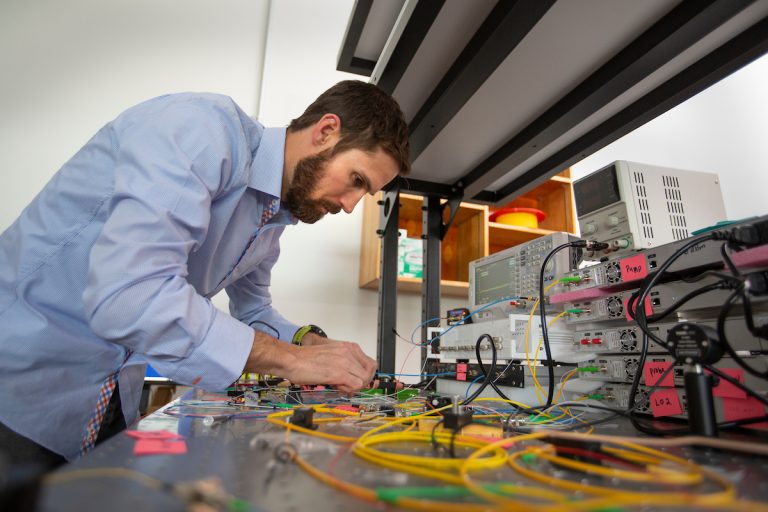NAU scientist contributes to significant advance in silicon photonics

Northern Arizona University assistant professor Ryan Behunin collaborated with a team of physicists from Yale and the University of Texas at Austin in discovering an innovative way to manipulate light in silicon. By demonstrating a new type of laser that amplifies light with sound waves in a silicon chip, the team's research represents a significant advance in the field of silicon photonics. Behunin contributed to the theory and modeling aspects of the project, the results of which were published in Science.
Having the ability to manipulate light in silicon could potentially represent a game-changer in computer chip technology.
"We've invested trillions of dollars in understanding silicon, because that's the material we use to create computer chips," Behunin said. "We can control silicon at the atomic level, make wafers of pure crystal silicon and even make a silicon crystal out of atoms that all have the same atomic weight. With this exquisite control, scientists and engineers have created devices on silicon chips that use electricity to perform all sorts of useful tasks."
However, the wires used in those devices send and process information relatively inefficiently because of the heat generated by electric current.
"In the field we're working in, silicon photonics, the dream is to replace a wire for electricity with its optical equivalent, a waveguide for light," Behunin said. "The idea is to leverage our vast knowledge about silicon to create chips that use light to efficiently and quickly process information."
Realizing the full potential of silicon photonics has challenged scientists for decades. Due to the element's intrinsic properties, it is extremely difficult to generate laser light in silicon"”a key ingredient for silicon photonics. With these findings, the team has taken a big step toward solving that problem.
"We demonstrated a new type of laser, the Brillouin laser, in silicon," Behunin said. "This project dramatically expanded the way light can be manipulated and controlled within silicon."
The laser is named for French physicist Léon Brillouin, for whom the effect of light-sound scattering is also named. By designing a new, specialized waveguide, the team's Brillouin laser uses sound to amplify light.
Uses and implications of the Brillouin laser
The laser's unique properties may enable applications ranging from timekeeping to new schemes for encoding and decoding information. The Brillouin laser can produce pure sound waves, in addition to emitting light. The emitted light can be used to power "photonic circuits," and the sound waves can be harnessed to carry out very sophisticated forms of precision sensing"”all possible on a small chip. There's still more to learn with Brillouin lasers in silicon.
"We've only scratched the surface with this work," Behunin said. "Using silicon, we can create a range of laser designs, each with unique properties customized for a specific application. First publication in Science is incredibly satisfying"
Behunin is second author of the paper announcing the team's results.
"Publishing in Science is incredibly satisfying," he said of his first article in the prestigious journal. Behunin credits primary author Nils Otterstrom, fellow researcher Eric Kittlaus and principal investigator Peter Rakich, all of Yale, for the insights and effort that led to publication.
"Nils and Eric are both incredibly smart and hardworking. Nils designed, fabricated and characterized the lasers, and Eric developed the waveguides," he said. "I was primarily involved in the theory and modeling aspects of the system. Peter is brilliant. It has been my privilege to work with him. This laser was his vision, which we set out to realize."
Behunin joined NAU's Department of Physics and Astronomy in 2017. He enjoys problems that simultaneously explore fundamental questions and applications. His research explores the physics of fluctuation-induced phenomena and optomechanics, investigating fundamental questions regarding the interaction of light, sound and matter"”from quantum friction to laser noise. Within optomechanics, Brillouin physics is his primary focus



































